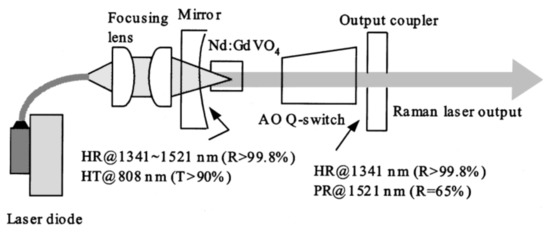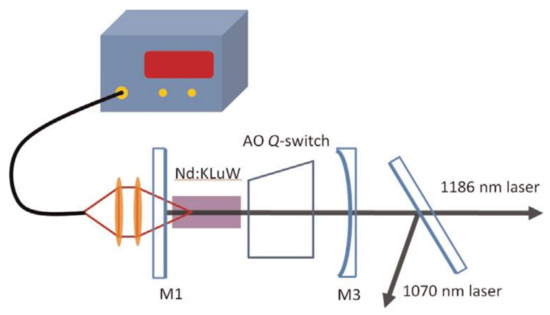In the past few decades, the multifunctional optical crystals for all-solid-state Raman lasers have been widely studied by many scholars due to their compactness, convenience and excellent performance. In this entry, we briefly show two kinds of multifunctional Raman crystals: self-Raman (laser and Raman effects) crystals and self-frequency-doubled Raman (frequency-doubling and Raman effects) crystals.
- multifunctional crystal
- Raman laser
- self-Raman
- self-frequency-doubled Raman
1. Introduction
Stimulated Raman scattering (SRS) is a simple and efficient method to extend the spectral range from ultraviolet to mid-infrared. In 1962, the SRS phenomenon was first detected by Woodbury and Ng when they studied Q-switched ruby lasers with nitrobenzene materials [1]. Thereafter, SRS was observed in liquid and gases. Compared with gas and liquid Raman media, solid-state Raman media have many excellent features such as good thermodynamic performance, narrow Raman line width and stable chemical properties, which are conducive to the generation of the Raman lasers with high reliability and high repetition frequency. A rapid expansion in the number of international research reports have emerged on yellow and eye-safe crystalline Raman lasers aimed at the development of practical devices for a wide range of applications, such as biomedical diagnostics, remote sensing, and laser therapies. Yellow and eye-safe crystalline Raman lasers can be obtained with a combination of frequency doubling and Raman effects, as well as the laser and Raman effects, respectively. Normally, these solid-state Raman laser sources need separate laser and Raman crystals or separate Raman and frequency doubling crystals, which results in a complex structure and a large insertion loss.
During recent decades, the multifunctional Raman optical crystal has emerged as a special kind of crystal, which possesses several effects within one crystal. As a result, the multifunctional Raman optical crystal has the advantages of compactness, easy operation, and low insertion loss [2]. Up to now, most multifunctional Raman optical crystals are self-Raman crystals with laser and Raman properties [3][4], and only a few multifunctional Raman optical crystals are self-frequency-doubled Raman crystals, with both frequency-doubled and Raman properties [5][6]. There are four kinds of self-Raman crystals: tungstate, vanadate, molybdate and silicate crystals. In 1985, the first self-Raman laser was realized by Andryunas et al. [7] with Nd ion doped tungstate potassium Nd:KGW/Nd:KYW at the flashlamp pump. Afterwards, there were no reports on self-Raman lasers for more than ten years, but the types of self-Raman media have been constantly increased in number [8][9][10]. In 1999, the first passively Q-switched (PQS) self-Raman laser was demonstrated with a Yb:KGW crystal by Lagatsky et al. [11]. In the following year, the first actively Q-switched (AQS) self-Raman laser was realized by Findeisen et al. [12] with the anisotropic Nd:KGW crystal. In 2002, Grabtchikov et al. [13] demonstrated the first continuous wave (CW) self-Raman laser with Yb:KYW crystal, and the corresponding optical power conversion efficiency was 10%. The vanadate YVO
During recent decades, the multifunctional Raman optical crystal has emerged as a special kind of crystal, which possesses several effects within one crystal. As a result, the multifunctional Raman optical crystal has the advantages of compactness, easy operation, and low insertion loss [2]. Up to now, most multifunctional Raman optical crystals are self-Raman crystals with laser and Raman properties [3,4], and only a few multifunctional Raman optical crystals are self-frequency-doubled Raman crystals, with both frequency-doubled and Raman properties [5,6]. There are four kinds of self-Raman crystals: tungstate, vanadate, molybdate and silicate crystals. In 1985, the first self-Raman laser was realized by Andryunas et al. [7] with Nd ion doped tungstate potassium Nd:KGW/Nd:KYW at the flashlamp pump. Afterwards, there were no reports on self-Raman lasers for more than ten years, but the types of self-Raman media have been constantly increased in number [8,9,10]. In 1999, the first passively Q-switched (PQS) self-Raman laser was demonstrated with a Yb:KGW crystal by Lagatsky et al. [11]. In the following year, the first actively Q-switched (AQS) self-Raman laser was realized by Findeisen et al. [12] with the anisotropic Nd:KGW crystal. In 2002, Grabtchikov et al. [13] demonstrated the first continuous wave (CW) self-Raman laser with Yb:KYW crystal, and the corresponding optical power conversion efficiency was 10%. The vanadate YVO
4
and GdVO
4 were later predicted to be excellent materials for SRS [14], and many vanadate self-Raman lasers have been gradually reported with high average powers (>5 W) and high conversion efficiencies (>20%) [15][16][17][18][19][20]. Moreover, the inclusion of second-harmonic generation (SHG) or sum-frequency generation (SFG) crystals has been verified to be an effective approach for yellow-orange-red generation with average output power up to 8.8 W and diode-visible power conversion efficiency of >30% [21]. Until now, only a few self-frequency-doubled Raman crystals have been demonstrated. For instance, in 2009, Liu et al. [5] used a single KTA crystal to perform self-frequency-doubled Raman conversion from the 1064 nm fundamental beam to the 573 nm yellow beam. Another self-frequency-doubled Raman crystal, BTM, was reported by Gao et al. [6] in 2013, and a maximum pulse energy of 5.6 mJ was attained for 589 nm yellow laser radiation.
were later predicted to be excellent materials for SRS [14], and many vanadate self-Raman lasers have been gradually reported with high average powers (>5 W) and high conversion efficiencies (>20%) [15,16,17,18,19,20]. Moreover, the inclusion of second-harmonic generation (SHG) or sum-frequency generation (SFG) crystals has been verified to be an effective approach for yellow-orange-red generation with average output power up to 8.8 W and diode-visible power conversion efficiency of >30% [21]. Until now, only a few self-frequency-doubled Raman crystals have been demonstrated. For instance, in 2009, Liu et al. [5] used a single KTA crystal to perform self-frequency-doubled Raman conversion from the 1064 nm fundamental beam to the 573 nm yellow beam. Another self-frequency-doubled Raman crystal, BTM, was reported by Gao et al. [6] in 2013, and a maximum pulse energy of 5.6 mJ was attained for 589 nm yellow laser radiation.
2. The Classification of Multifunctional Raman Crystals
2.1. Self-Raman Crystals
2.1.1. Vanadate
As the most popular multifunctional Raman crystal, the vanadate self-Raman crystals include Nd:YVO
4 [15][16][20][21][22][23][24][25][26][27][28][29][30][31][32][33][34][35][36][37][38][39][40][41][42][43][44][45][46][47][48][49][50][51][52][53][54][55][56][57][58][59][60][61][62], Nd:GdVO
[15,16,20,21,22,24,25,26,27,28,29,30,31,32,33,34,35,36,37,38,39,40,41,42,43,44,45,46,47,48,49,50,51,52,53,54,55,56,57,58,59,60,61,62,63], Nd:GdVO
4 [18][19][63][64][65][66][67][68][69][70][71][72][73][74][75][76][77], Yb:YVO
[18,19,64,65,66,67,68,69,70,71,72,73,74,75,76,77,78], Yb:YVO
4 [17], and Nd:LuVO
[17], and Nd:LuVO
4 [78][79]. Among these self-Raman laser crystals, Nd:YVO
[79,80]. Among these self-Raman laser crystals, Nd:YVO
4
has been the most extensively researched and widely employed due to its large Raman gain coefficient, strong absorption of pump radiation over a broad bandwidth, and large emission cross section. Its strongest vibrational Raman mode is located at 890 cm
−1
with Raman line width of 3.0 cm
−1 and Raman gain coefficient of ~5 cm/GW [14]. In addition, two weak Raman shifts are 816 and 259 cm
and Raman gain coefficient of ~5 cm/GW [14]. In addition, two weak Raman shifts are 816 and 259 cm
−1
with respective Raman gain coefficients of 2.6 and 2.3 cm/GW for c-cut Nd:YVO
4 crystal with Z(XX) scattering configuration [59]; and 840 and 379 cm
crystal with Z(XX) scattering configuration [60]; and 840 and 379 cm
−1
with respective Raman gain coefficients of 2.6 and 0.9 cm/GW for a-cut Nd:YVO
4 crystal with X(ZZ) scattering configuration [80]. The Nd-doped YVO
crystal with X(ZZ) scattering configuration [81]. The Nd-doped YVO
4
crystal belongs to the zircon type D
4h
tetragonal space group, and its stimulated radiation cross section parallel to the c axis (a-cut, σ = 25 × 10
−19
cm
2
at 1064 nm) is four times higher than the cross section orthogonal to the c axis (c-cut, σ = 6.5 × 10
−19
cm
2 at 1066 nm) [23].
at 1066 nm) [24].
In 2004, the first PQS Nd:YVO
4 self-Raman laser was demonstrated by Chen [23], as shown in
self-Raman laser was demonstrated by Chen [24], as shown in
Figure 1. At the incident pump power of 2.0 W, the laser system produced 0.125 W of average output power at 1178.6 nm with 6.3% of conversion efficiency from diode power to Raman output power. Then, Chen [15][16] demonstrated the AQS Nd:YVO
. At the incident pump power of 2.0 W, the laser system produced 0.125 W of average output power at 1178.6 nm with 6.3% of conversion efficiency from diode power to Raman output power. Then, Chen [15,16] demonstrated the AQS Nd:YVO
4
self-Raman lasers at 1176 and 1525 nm with maximum average output powers of 1.5 and 1.2 W, respectively, corresponding to conversion efficiencies of 13.9% and 8.9%. In 2006, the first CW Nd:YVO
4 self-Raman laser was realized by Burakevich et al. [26], and the maximum output power at 1177 nm was 50 mW with optical power conversion efficiency of 2%. In 2008, a passively mode-locked Nd:YVO
self-Raman laser was realized by Burakevich et al. [27], and the maximum output power at 1177 nm was 50 mW with optical power conversion efficiency of 2%. In 2008, a passively mode-locked Nd:YVO
4 self-Raman laser at 1176 nm was obtained by M. Weitz [28] with a slow saturable absorber, and maximum average power of 420 mW was delivered with a duration of 4.8 ps and a repetition rate of 73 MHz. An efficient AQS eye-safe Raman laser at 1525 nm using a double-end diffusion-bonded Nd:YVO
self-Raman laser at 1176 nm was obtained by M. Weitz [29] with a slow saturable absorber, and maximum average power of 420 mW was delivered with a duration of 4.8 ps and a repetition rate of 73 MHz. An efficient AQS eye-safe Raman laser at 1525 nm using a double-end diffusion-bonded Nd:YVO
4 crystal was reported by Chang et al. [30] in 2009, and average power of 2.23 W was generated with a conversion efficiency of 13%. In 2016, a high power CW YVO
crystal was reported by Chang et al. [31] in 2009, and average power of 2.23 W was generated with a conversion efficiency of 13%. In 2016, a high power CW YVO
4
/Nd:YVO
4
/YVO
4 self-Raman laser at 1176 nm, pumped by a wavelength-locked 878.9 nm diode laser, was reported by Fan et al. [20], corresponding to maximum output power of 5.3 W and optical conversion efficiency of 20%. To our knowledge, this is the highest power and efficiency among Nd:YVO
self-Raman laser at 1176 nm, pumped by a wavelength-locked 878.9 nm diode laser, was reported by Fan et al. [20], corresponding to maximum output power of 5.3 W and optical conversion efficiency of 20%. To our knowledge, this is the highest power and efficiency among Nd:YVO
4
self-Raman lasers up to now. In addition, self-Raman lasers in combination with SHG or SFG can be used to produce yellow light sources. In 2007, the first CW yellow laser at 588 nm was realized by intracavity frequency doubling Nd:YVO
4 self-Raman laser [27], corresponding to maximum yellow output power of 140 mW and diode-to-yellow conversion efficiency of 4.4%, respectively. In 2019, a 4.0 W CW Nd:YVO
self-Raman laser [28], corresponding to maximum yellow output power of 140 mW and diode-to-yellow conversion efficiency of 4.4%, respectively. In 2019, a 4.0 W CW Nd:YVO
4 self-Raman yellow laser at 588 nm was reported by Chen [58] with conversion efficiency of 12.7%. In 2020, Chen [21] demonstrated an efficient intracavity frequency-doubled AQS Nd:YVO
self-Raman yellow laser at 588 nm was reported by Chen [59] with conversion efficiency of 12.7%. In 2020, Chen [21] demonstrated an efficient intracavity frequency-doubled AQS Nd:YVO
4
self-Raman yellow laser at 588 nm with maximum output power of 8.8 W and diode-to-yellow conversion efficiency of 34%. To the best of our knowledge, this is the highest power and efficiency among self-Raman yellow lasers. In the same year, a PQS YVO
4
/Nd:YVO
4
/YVO
4 self-Raman yellow laser at 589 nm was demonstrated by Chen et al. [62]. Maximum output power of 0.66 W was attained with an optical conversion efficiency of 3.8%.
self-Raman yellow laser at 589 nm was demonstrated by Chen et al. [63]. Maximum output power of 0.66 W was attained with an optical conversion efficiency of 3.8%.
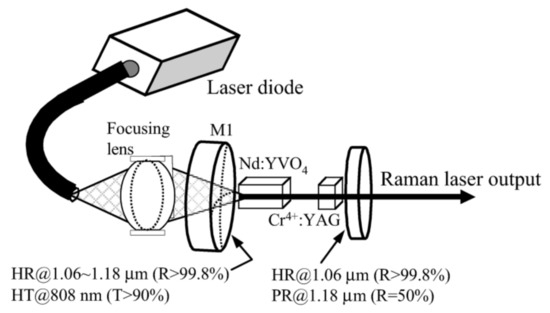
Figure 1.
Schematic of the passively Q-switched Nd:YVO
4 self-Raman laser [23].
self-Raman laser [24].
Nd:GdVO
4
crystal is the isostructural body of the Nd:YVO
4
crystal, which also has a zircon structure with tetragonal space group. Compared to the Nd:YVO
4
crystal, the Nd:GdVO
4
crystal has higher thermal conductivity, which could be beneficial for high power self-Raman laser operation. The strongest Raman shift mode of the Nd:GdVO
4
crystal is 882 cm
−1
with line width of 3.5 cm
−1 and Raman gain coefficient of 4.5 cm/GW [65]. In addition, the secondary Raman transition is located at 382 cm
and Raman gain coefficient of 4.5 cm/GW [66]. In addition, the secondary Raman transition is located at 382 cm
−1 for the X(ZZ)X configuration, and the corresponding Raman gain was estimated to be 0.7cm/GW [72].
for the X(ZZ)X configuration, and the corresponding Raman gain was estimated to be 0.7cm/GW [73].
In 2004, Chen [
] reported a PQS Nd:GdVO
4
self-Raman laser at 1175.6 nm by using a Cr
4+
:YAG saturable absorber, and maximum peak power of 8.4 kW was obtained with conversion efficiency of 7%. Due to its large emission cross section and short upper state lifetime, the Cr
4+
:YAG saturable absorber is not suitable for the PQS Nd:GdVO
4 self-Raman laser [64]. In the same year, benefiting from its large absorption cross section and thermal conductivity, the LiF:F
self-Raman laser [65]. In the same year, benefiting from its large absorption cross section and thermal conductivity, the LiF:F
2−
crystal was employed as a saturable absorber to realize the PQS Nd:GdVO
4 self-Raman laser [64]. Maximum peak power of 9 kW was achieved with conversion efficiency of 2%. Several months later, the first AQS Nd:GdVO
self-Raman laser [65]. Maximum peak power of 9 kW was achieved with conversion efficiency of 2%. Several months later, the first AQS Nd:GdVO
4 self-Raman laser operating at 1521 nm was delivered by Chen [18] as exhibited in
self-Raman laser operating at 1521 nm was delivered by Chen [18] as exhibited in
, and maximum output power of 1.18 W was achieved with an optical-to-optical conversion efficiency of 8.7%. In 2012, a 4.1 W CW Nd:GdVO
4 self-Raman laser using double-end polarized pumping at 880 nm was realized by Lin et al. [73] with an optical conversion efficiency of 11.2%. To our knowledge, this is the highest power among Nd:GdVO
self-Raman laser using double-end polarized pumping at 880 nm was realized by Lin et al. [74] with an optical conversion efficiency of 11.2%. To our knowledge, this is the highest power among Nd:GdVO
4 self-Raman lasers. In 2013, Wang et al. [74] demonstrated a PQS Nd:GdVO
self-Raman lasers. In 2013, Wang et al. [75] demonstrated a PQS Nd:GdVO
4
self-Raman laser at 1176 nm with maximum output power of 0.52 W and optical-to-optical conversion efficiency of 10.3%. Additionally, yellow light sources were obtained through intracavity SHG or SFG of the Nd:GdVO
4 self-Raman lasers. In 2008, a 2.51 W CW yellow emission at 586.5 nm was demonstrated by Lee et al. [67] through intracavity frequency-doubling of a Nd:GdVO
self-Raman lasers. In 2008, a 2.51 W CW yellow emission at 586.5 nm was demonstrated by Lee et al. [68] through intracavity frequency-doubling of a Nd:GdVO
4
self-Raman laser. Two years later, a 5.3 W CW laser emission at 559 nm with high efficiency (21%) was achieved by intracavity sum-frequency mixing of fundamental and first-Stokes emission in a self-Raman Nd:GdVO
4 laser [68].
laser [69].
Compared to Nd:YVO
4
crystal, Yb:YVO
4
crystal has the strong and comparatively broad absorption band near 985 nm, the extremely low quantum defect (~3.5%), and the broad gain bandwidth (~30 nm). Moreover, Yb:YVO
4
crystal has a moderate Raman gain coefficient of 4.5 cm/GW at a Raman shift of 892 cm
−1
. In 2005, the PQS Yb:YVO
4 self-Raman laser at 1119.5 nm was achieved by Kisel et al. [17] with pulse energy of 3.6 μJ and pulse duration of 6 ns.
self-Raman laser at 1119.5 nm was achieved by Kisel et al. [17] with pulse energy of 3.6 μJ and pulse duration of 6 ns.
Similar to the Nd:YVO
4
and Nd:GdVO
4
crystals, the Nd:LuVO
4
crystal also has a zircon structure and a space group of I4
1
/amd. Compared to the Nd:YVO
4
and Nd:GdVO
4
crystals, the Nd:LuVO
4
crystal has larger emission cross section (14.6 × 10
−19
cm
2
) and absorption cross section (6.9 × 10
−19
cm
2
). Moreover, the Nd:LuVO
4 crystal has a high damage threshold [81][82], and is easy to process. Its Raman frequency shift was determined to be 900 cm
crystal has a high damage threshold [83,84], and is easy to process. Its Raman frequency shift was determined to be 900 cm
−1
with a line width of 5 cm
−1 and Raman gain coefficient above 3.2 cm/GW [79]. In 2009, a PQS Nd:LuVO
and Raman gain coefficient above 3.2 cm/GW [80]. In 2009, a PQS Nd:LuVO
4 self-Raman laser at 1178.8 nm was demonstrated by Kaminskii et al. [78], corresponding to maximum output power of 0.12 W and conversion efficiency of 5%, respectively. In 2010, Lu et al. [79] reported an efficient CW double-end diffusion-bonded Nd:LuVO
self-Raman laser at 1178.8 nm was demonstrated by Kaminskii et al. [79], corresponding to maximum output power of 0.12 W and conversion efficiency of 5%, respectively. In 2010, Lu et al. [80] reported an efficient CW double-end diffusion-bonded Nd:LuVO
4
self-Raman yellow laser at 589 nm with maximum output power of 3.5 W and conversion efficiency of 13.3%.
2.1.2. Tungstate
According to our surveys, tungstate self-Raman crystals include Nd:KGd(WO
4
)
2 (Nd:KGW) [2][12][83][84][85][86][87][88][89][90][91][92], Yb:KGd(WO
(Nd:KGW) [2,12,85,86,87,88,89,90,91,92,93,94], Yb:KGd(WO
4
)
2 (Yb:KGW) [11][93][94][95], Nd:PbWO
(Yb:KGW) [11,95,96,97], Nd:PbWO
4 (Nd:PWO) [96], Yb:KY(WO
(Nd:PWO) [98], Yb:KY(WO
4
)
2 (Yb:KYW) [13], Nd:BaWO
(Yb:KYW) [13], Nd:BaWO
4 [97], Nd:SrWO
[99], Nd:SrWO
4
)
2 (Yb:KLuW) [99] and Nd:KLu(WO
(Yb:KLuW) [101] and Nd:KLu(WO
4
)
2 (Nd:KLuW) [100].
(Nd:KLuW) [102].
The anisotropic Nd:KGW crystal is the most commonly used self-Raman crystal in tungstate. Nd:KGW crystal has a large emission cross section (4.3 × 10
−19
cm
2) and a wide absorption spectrum [85]. In addition, this crystal can be doped with a high concentration of Nd ions without significant concentration quenching and deterioration of crystal quality. It has two strong Raman vibrational modes at 767 cm
) and a wide absorption spectrum [86]. In addition, this crystal can be doped with a high concentration of Nd ions without significant concentration quenching and deterioration of crystal quality. It has two strong Raman vibrational modes at 767 cm
−1
(
Ng
) and 901 cm
−1
(
Nm
) in orthogonal orientations with similar Raman line width of 5.4 cm
−1, and the corresponding Raman gain coefficients are 4.4 and 3.3 cm/GW, respectively [25].
, and the corresponding Raman gain coefficients are 4.4 and 3.3 cm/GW, respectively [26].
In 1985, the first self-Raman conversion was observed by Andryunas et al. [83] in Nd:KGW and Nd:KYW crystals, and output energy of 11 mJ was obtained with conversion efficiency of 6.14%. In 1999, the first PQS Nd:KGW self-Raman laser at 1181 nm was realized by Grabtchikov et al. [85], corresponding to output power of 4.8 mW and conversion efficiency of 0.7%, respectively. In 2000, the first acousto-optic Q-switched Nd:KGW self-Raman laser at 1162 nm was achieved by Findeisen et al. [12] with maximum pulse energy of 0.1 mJ. Later, Raman radiation was converted into the yellow laser at 581 nm by the external frequency-doubling technology with the LiB
In 1985, the first self-Raman conversion was observed by Andryunas et al. [85] in Nd:KGW and Nd:KYW crystals, and output energy of 11 mJ was obtained with conversion efficiency of 6.14%. In 1999, the first PQS Nd:KGW self-Raman laser at 1181 nm was realized by Grabtchikov et al. [86], corresponding to output power of 4.8 mW and conversion efficiency of 0.7%, respectively. In 2000, the first acousto-optic Q-switched Nd:KGW self-Raman laser at 1162 nm was achieved by Findeisen et al. [12] with maximum pulse energy of 0.1 mJ. Later, Raman radiation was converted into the yellow laser at 581 nm by the external frequency-doubling technology with the LiB
3
O
5
crystal, and the schematic diagram is displayed in
.
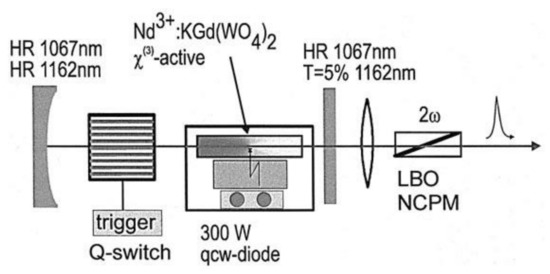
Figure 3. Schematic of the first actively Q-switched self-Raman laser [12].
Schematic of the first actively Q-switched self-Raman laser [12].
In 2005, Demidovich et al. [2] reported the first CW Nd:KGW self-Raman laser at 1181 nm with maximum output power of 54 mW and conversion efficiency of 2.6%, as depicted in
In 2005, Demidovich et al. [2] reported the first CW Nd:KGW self-Raman laser at 1181 nm with maximum output power of 54 mW and conversion efficiency of 2.6%, as depicted in
Figure 4. In the same year, an AQS Nd:KGW self-Raman laser at 1181 nm was realized by Hamano et al. [88] with maximum output power of 0.8 W and optical conversion efficiency of 14%. In 2014, Tang et al. [92] reported a CW Nd:KGW self-Raman laser at 1077.9 nm with maximum output power of 0.42 W and conversion efficiency of 16.8%.
. In the same year, an AQS Nd:KGW self-Raman laser at 1181 nm was realized by Hamano et al. [90] with maximum output power of 0.8 W and optical conversion efficiency of 14%. In 2014, Tang et al. [94] reported a CW Nd:KGW self-Raman laser at 1077.9 nm with maximum output power of 0.42 W and conversion efficiency of 16.8%.
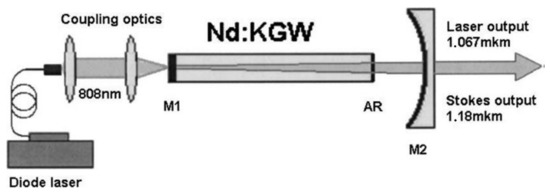
Figure 4. Schematic of the first continuous-wave self-Raman laser [2].
Compared to Nd:KGW crystal, Yb:KGW crystal is a promising material for high efficiency due to small quantum defect, high quantum efficiency, and broad absorption bandwidth. Moreover, Yb:KGW crystal is an ideal material for the self-Raman laser because of its large absorption cross section (5.3 × 10
−20
cm
2
), large emission cross section (2.8 × 10
−20
cm
2) and high nonlinear optical susceptibility [94]. Its two main Raman frequency shift modes are 768 cm
) and high nonlinear optical susceptibility [96]. Its two main Raman frequency shift modes are 768 cm
−1
(
Ng
) and 901 cm
−1
(
Nm). In 1999, the first PQS Yb:KGW self-Raman laser at 1139 nm was attained by Lagatsky et al. [11]. The maximum output power and pulse energy were 7 mW and 0.4 μJ, respectively. In 2003, Kisel et al. [93] demonstrated a PQS Yb:KGW self-Raman laser at 1145 nm with maximum output power of 0.11 W and conversion efficiency from fundamental-to-first Stokes as high as 40%. In 2013, a CW Yb:KGW self-Raman laser at 1110.5 nm was attained by Chang et al. [94], corresponding to the diode-to-Stokes conversion efficiency of 21.8% and highest output power of 1.7 W. In 2019, a quasi-CW Yb:KGW self-Raman laser at 1096 nm was reported by Ferreira et al. [95] with maximum output power of 4.5 W and optical conversion efficiency of 32%.
). In 1999, the first PQS Yb:KGW self-Raman laser at 1139 nm was attained by Lagatsky et al. [11]. The maximum output power and pulse energy were 7 mW and 0.4 μJ, respectively. In 2003, Kisel et al. [95] demonstrated a PQS Yb:KGW self-Raman laser at 1145 nm with maximum output power of 0.11 W and conversion efficiency from fundamental-to-first Stokes as high as 40%. In 2013, a CW Yb:KGW self-Raman laser at 1110.5 nm was attained by Chang et al. [96], corresponding to the diode-to-Stokes conversion efficiency of 21.8% and highest output power of 1.7 W. In 2019, a quasi-CW Yb:KGW self-Raman laser at 1096 nm was reported by Ferreira et al. [97] with maximum output power of 4.5 W and optical conversion efficiency of 32%.
Compared with the doped KGW crystal, tungstate Nd:PWO crystal has higher Raman gain coefficient (8.4 cm/GW), and the corresponding Raman shift is 901 cm
−1
with line width of 4.3 cm
−1 [101]. In 2001, a PQS Nd:PWO self-Raman laser at 1170 nm was produced by Chen et al. [96] with maximum output energy of 2.5 μJ and conversion efficiency of 0.1%.
[103]. In 2001, a PQS Nd:PWO self-Raman laser at 1170 nm was produced by Chen et al. [98] with maximum output energy of 2.5 μJ and conversion efficiency of 0.1%.
The Yb:KYW crystal has a broad absorption band centered at 981 nm, relatively large absorption coefficient (17 cm
−1
for the typical 5 at% Yb
3+ concentration), and relatively inexpensive, reproducible, and easy growth [13]. Its Raman frequency shift and Raman gain coefficient are 905 cm
concentration), and relatively inexpensive, reproducible, and easy growth [13]. Its Raman frequency shift and Raman gain coefficient are 905 cm
−1 and 5.1 cm/GW, respectively [101][102]. In 2002, Grabtchikov et al. [13] reported a PQS Yb:KYW self-Raman laser at 1130 nm with maximum output power of 2 mW.
and 5.1 cm/GW, respectively [103,104]. In 2002, Grabtchikov et al. [13] reported a PQS Yb:KYW self-Raman laser at 1130 nm with maximum output power of 2 mW.
Nd:BaWO
4
and Nd:SrWO
4
crystals have similar stimulated Raman scattering cross sections as Nd:KGW crystal. Raman gain coefficients are 8.5 and 5 cm/GW at the Raman shift modes of 926 and 921 cm
−1
, respectively, corresponding to the Raman line widths of 1.6 and 3.0 cm
−1 [97]. In 2004, a PQS Nd:SrWO
[99]. In 2004, a PQS Nd:SrWO
4 self-Raman laser at 1170 nm was generated by Jelinkova et al. [98] with a pulse energy of 1.3 mJ. In 2006, the PQS Nd:SrWO
self-Raman laser at 1170 nm was generated by Jelinkova et al. [100] with a pulse energy of 1.3 mJ. In 2006, the PQS Nd:SrWO
4
self-Raman laser at 1170 nm and Nd:BaWO
4 self-Raman laser at 1169 nm were reported by Sulc et al. [97], and the corresponding pulse energies were 1.23 and 0.81 mJ, respectively.
self-Raman laser at 1169 nm were reported by Sulc et al. [99], and the corresponding pulse energies were 1.23 and 0.81 mJ, respectively.
Yb:KLuW crystal belongs to the monoclinic space group C
2/C, and its main absorption center and fluorescence lifetime are 981 nm and 375 μs, respectively. In addition, the physical and spectral properties of Yb:KLuW crystals are similar to those of Yb:KGW and Yb:KYW crystals [103]. The main Raman shift modes are located at 907 and 757 cm
, and its main absorption center and fluorescence lifetime are 981 nm and 375 μs, respectively. In addition, the physical and spectral properties of Yb:KLuW crystals are similar to those of Yb:KGW and Yb:KYW crystals [105]. The main Raman shift modes are located at 907 and 757 cm
−1 [103]. In 2005, Liu et al. [99] demonstrated a PQS Yb:KLuW self-Raman laser at 1137.6 nm, as illustrated in
[105]. In 2005, Liu et al. [101] demonstrated a PQS Yb:KLuW self-Raman laser at 1137.6 nm, as illustrated in
. Maximum output power of 0.4 W was obtained with conversion efficiency of 5.7%.
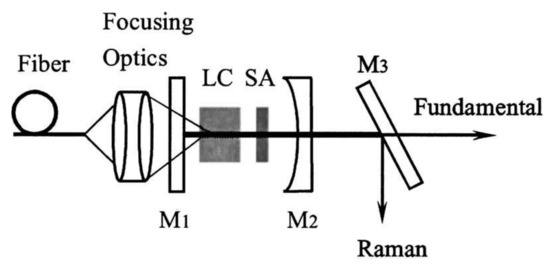
Figure 5. Schematic diagram of the PQS Yb:KLuW self-Raman laser setup; LC, laser crystal; SA, saturable absorber [99].
Schematic diagram of the PQS Yb:KLuW self-Raman laser setup; LC, laser crystal; SA, saturable absorber [101].
Nd:KLuW crystal belongs to the monoclinic space group C
2/C
with an emission wavelength of 1070 nm. The absorption cross section of Nd:KLuW crystal at 812 nm is 7.93 × 10
−20
cm
2
, and the emission cross section at 1.07 μm is 2.4 × 10
−19
cm
2 [104]. The two strongest Raman shifts are located at 907 and 757 cm
[106]. The two strongest Raman shifts are located at 907 and 757 cm
−1 [105]. In 2015, an AQS Nd:KLuW self-Raman laser at 1185 nm was produced by Cong et al. [100], as shown in
[107]. In 2015, an AQS Nd:KLuW self-Raman laser at 1185 nm was produced by Cong et al. [102], as shown in
, and the maximum output power of 1.5 W was attained with conversion efficiency of 9.8%.
2.1.3. Molybdate
Molybdate self-Raman crystals consist of Nd:PbMoO
4
crystal and Nd:SrMoO
4
crystal. The Raman gain coefficient of Nd:PbMoO
4
crystal is two or three times higher than those of YVO
4
, GdVO
4 and KGW crystals [106]. Its Raman frequency shift is 871 cm
and KGW crystals [108]. Its Raman frequency shift is 871 cm
−1
with line width of 8.0 cm
−1 [105]. In 2005, the PQS Nd:PbMoO
[107]. In 2005, the PQS Nd:PbMoO
4 self-Raman laser at first Stoke wavelength of 1163 nm was reported by Basiev et al. [106] with pulse energy of 6 μJ.
self-Raman laser at first Stoke wavelength of 1163 nm was reported by Basiev et al. [108] with pulse energy of 6 μJ.
The a-cut Nd:SrMoO
4
crystal has a peak emission cross section of 3 × 10
−19
cm
2
and fluorescence decay time of 180 ms. Its Raman gain coefficient (5.7 cm/GW) is comparable to those of YVO
4
and GdVO
4 crystals [107]. The Raman shift of Nd:SrMoO
crystals [109]. The Raman shift of Nd:SrMoO
4
crystal is 887 cm
−1
with line width of 2.5 cm
−1 [105]. In 2009, Basiev et al. [107] demonstrated a PQS Nd:SrMoO
[107]. In 2009, Basiev et al. [109] demonstrated a PQS Nd:SrMoO
4
self-Raman laser, as exhibited in
. Maximum pulse energy of 21 μJ was obtained at a wavelength of 1163 nm.
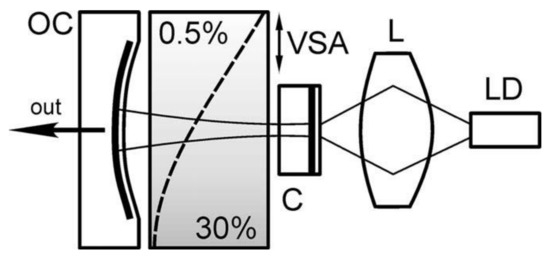
Figure 7.
Schematic diagram of the PQS Nd:GdVO
4 self-Raman laser: LD, laser diode; L, focusing lens; C, laser crystal; VSA, saturable absorber with variable transmission; OC, output coupler [107].
self-Raman laser: LD, laser diode; L, focusing lens; C, laser crystal; VSA, saturable absorber with variable transmission; OC, output coupler [109].
2.2. Self-Frequency-Doubled Raman Crystals
2.2.1. KTiOAsO4 (KTA) and KTiOPO4 (KTP)
KTA crystal has an orthorhombic structure with non-centro-symmetric point group C
2v
(mm
2
) and space group Pna2
1
(Z58). Due to the high nonlinear coefficient (d
33
= 16.2 pm/V) and high damage threshold (>300 MW/cm
2), KTA crystal has been used in optical parametric oscillators (OPOs) since the 1990s [108][109] In 1996, Tu et al. [110] proved that KTA is an excellent Raman medium with Raman gain coefficients of ~2.5 cm/GW at 234 cm
), KTA crystal has been used in optical parametric oscillators (OPOs) since the 1990s [111,112]. In 1996, Tu et al. [113] proved that KTA is an excellent Raman medium with Raman gain coefficients of ~2.5 cm/GW at 234 cm
−1
and ~0.6 cm/GW at 671 cm
−1
, respectively, and corresponding Raman line widths of 5.8 and 19 cm
−1. The KTA crystal was first reported by Liu et al. [5] as a self-frequency-doubled Raman crystal in 2009, as displayed in
. The KTA crystal was first reported by Liu et al. [5] as a self-frequency-doubled Raman crystal in 2009, as displayed in
. The KTA self-frequency-doubled Raman laser at 573 nm was realized with Raman shift of 671 cm
−1
, and maximum output power of 0.82 W was obtained with conversion efficiency of 7.5%.
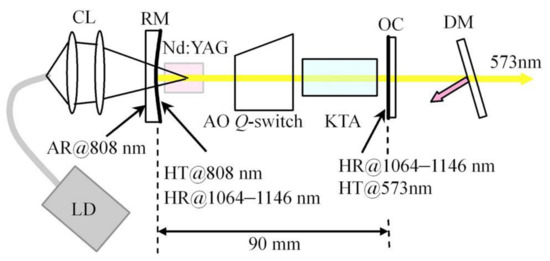
Figure 8.
Schematic diagram of the KTiOAsO
4 (
KTA) self-frequency-doubled Raman laser [5]: LD, laser diode; CL, coupling lens; RM, rear mirror; OC, output coupler; DM, dichroic mirror; AO, acousto-optic; AR, antireflection; HT, high transmission; HR, high reflection.
KTP crystal belongs to the family of KTA crystal. KTP crystal possesses the superior qualities of a high nonlinear coefficient and a high damage threshold [111]. In 2005, KTP crystal was recognized as a self-frequency-doubled Raman crystal by Chen [111], and its strongest Raman shift is 270 cm
KTP crystal belongs to the family of KTA crystal. KTP crystal possesses the superior qualities of a high nonlinear coefficient and a high damage threshold [114]. In 2005, KTP crystal was recognized as a self-frequency-doubled Raman crystal by Chen [114], and its strongest Raman shift is 270 cm
−1
with Raman gain coefficient of ~2.5 cm/GW. As depicted in
, the KTP self-frequency-doubled Raman laser at 548 nm was realized from the AQS 1064 nm Nd:YAG laser, and maximum output power of 0.25 W was obtained with conversion efficiency of 2.5%.
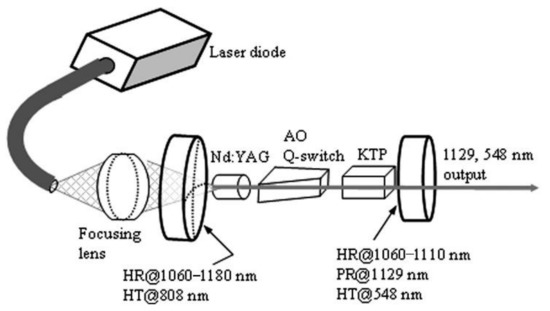
Figure 9. Schematic diagram of the KTP self-frequency-doubled Raman laser [111]: AO, acousto-optic; PR, partial reflection; HT, high transmission; HR, high reflection.
Schematic diagram of the KTP self-frequency-doubled Raman laser [114]: AO, acousto-optic; PR, partial reflection; HT, high transmission; HR, high reflection.
2.2.2. BaTeMo2O9 (BTM)
BTM crystallized in a monoclinic system with space group P2
1 [112]. In 2012, Yu et al. confirmed that the BTM crystal has a wide transmission band (0.4–5 μm), large nonlinear coefficient (d
[115]. In 2012, Yu et al. confirmed that the BTM crystal has a wide transmission band (0.4–5 μm), large nonlinear coefficient (d
31
= 9.88 pm/V) and high optical damage threshold (544 MW/cm
2), flexible phase-matching, and high chemical, and mechanical stabilities [113]. Its strongest Raman shift is 915.2 cm
), flexible phase-matching, and high chemical, and mechanical stabilities [116]. Its strongest Raman shift is 915.2 cm
−1
with line width of ~4.4 cm
−1 [6]. In 2013, the BTM crystal was employed as self-frequency-doubled Raman crystal to generate the yellow laser at 589 nm, as illustrated in
[6]. In 2013, the BTM crystal was employed as self-frequency-doubled Raman crystal to generate the yellow laser at 589 nm, as illustrated in
Figure 10 [6]. Maximum pulse energy of 5.6 mJ was achieved at a pump pulse energy of 48 mJ, corresponding to optical-to-optical conversion efficiency of 11.7%.
[6]. Maximum pulse energy of 5.6 mJ was achieved at a pump pulse energy of 48 mJ, corresponding to optical-to-optical conversion efficiency of 11.7%.

Figure 10. Schematic diagram of the BaTeMo2O9 (BTM) self-frequency-doubled Raman laser at 589 nm [6].

